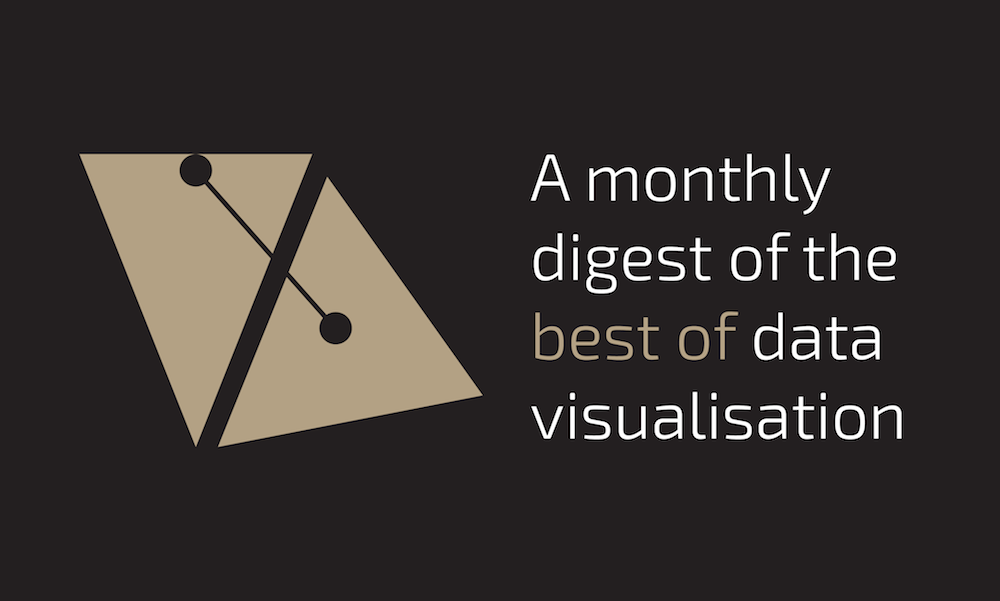At the end of each month I pull together a collection of links to some of the most relevant, interesting or thought-provoking web content I’ve come across during the previous month. Here’s the latest collection from October 2020.
Notes: the items listed may not have been necessarily published during this month, rather discovered during the month. Some links point to paywall items. The details shown below label the platform/site each item is published on – not necessarily the actual author – and a brief selective description.
Visualisations & Infographics
Covering latest visualisation, infographic or other related design works.
@adamemccann | ‘Here is an interactive portrait of Trump where every dot in his face is a false or misleading claim’
@lizbravob | ‘My submission for #MakeoverMonday Week 43, Apparel Exports to US. Visualization is inspired by clothing patterns.’
El Pais | ‘A room, a bar and a classroom: how the coronavirus is spread through the air’
@carlbaker | ‘New version of the small-area covid map/cartogram’
Washington Post | ‘This is what fuels the West’s infernos’
New York Times | ‘Trump Can Still Make a Difference on Masks’
Science Museum | ‘Colour & Shape: Using Computer Vision to Explore the Science Museum Group Collection’
NZZ | ‘These states will decide the US presidential election’
Roadtolarissa | ‘Election Forecast Correlations’
@darrenlonghk | ‘The total number of coronavirus cases in the US is roughly equal to the entire population of Hong Kong’
Morgenpost | ’30 years of German unity – 30 cards’
Washington Post | ‘Scientists have a powerful new tool for controlling the coronavirus: Its own genetic code.’
@ferranmorales | ‘The Big Three’
New York Times | ‘The President’s Taxes: The Swamp That Trump Built’
New York Times | ‘The President’s Taxes: Charting an Empire: A Timeline of Trump’s Finances’
FT | ‘Covid-19: The global crisis — in data’
Truth and Beauty | ‘Waves of Interest: Tracing Google Search Interest in US Election Years’
@malorieblackman | ‘These intricate, beautiful hairstyles also once saved lives.’
New York Times | ‘In the Amazon, Today’s Environmental Problems Become Tomorrow’s Catastrophes’
@neilrkaye | ‘I decided to make an updated and improved animating Mercator animation’
Economist | ‘It’s better to be a poor pupil in a rich country than the reverse’
The Guardian | ‘The maps that show life is slowly getting better’
DX Lab | ‘We Are What We Steal.’
Gramener | ‘The Nashville Presidential Debate’
FiveThirtyEight | ‘Explore The Ways Trump Or Biden Could Win The Election’
@webk1d | ‘Our new data visualization shows all 12,774 demonstrations that have been registered in Berlin since 2018.’
@stamen | ‘New work! Visualizing fifty years of automatic street photographs by Ed Ruscha on Sunset Boulevard’
@W_R_Chase | ‘The Retired: A visual history of the Atlantic’s worst hurricanes’
Bloomberg | ‘Tracking the Atlantic Hurricane Season’
@SonjaKuijpers | ‘New Project! The layout shows the 24 Sekki and 72 Ko (the phases of the season) of the Japanese seasonal calendar’
@nytimes | ‘These are 922 of the most powerful people in America.’
@SchofieldAngela | ‘11,000 angels suspended over the nave of Ripon Cathedral, made by volunteers and school children. They are a tribute to key workers and those who have died from coronavirus.’
Articles
These are references to written articles, discourse or interviews about visualisation.
Nightingale | ‘Making Census Data Open, Accessible and Useful for Real People’
Fast Company | ‘To tell the real story, data journalist Mona Chalabi draws imperfect lines’
Our World in Data | ‘Why is life expectancy in the US lower than in other rich countries?’
The Guardian | ‘Without learning to think statistically, we’ll never know when people are bending the truth’
The McGill Tribune | ‘When life gives you data, make visual art’
Learning & Development
These links cover presentations, tutorials, podcasts, academic papers, case-studies, how-tos etc.
Nature | ‘The misuse of colour in science communication’
@ieeevis | ‘Sinestream is a variant of streamgraphs which can improve its readability by minimizing sine illusion effects.’
@ieeevis | ‘Sequence Braiding, a visualization technique to represent sequences of events that helps in detecting trends and patterns in the data.’
@palewire | ‘I gave a presentation today at an all-hands LA Times meeting about our Data Graphics department. It was my attempt to explain what we do and why I think it’s working.’
Subject News
Includes announcements within the field, such as new sites or resources, new book titles and other notable developments.
@AlexKale17 | ‘My paper with Jessica Hullman & Matthew Kay on “Visual Reasoning Strategies for Effect Size Judgments and Decisions” won Best Paper at IEEE InfoVis 2020!’
@cambecc | ‘Earth.nullschool.net has a new UI starting today!’
Fast Company | ‘This year’s Innovation by Design Awards’
@tjukanov | ‘The #30DayMapChallenge 2020 categories are here.’
Nightingale | ‘Introducing Outlier — A Conference Hosted by the Data Visualization Society’
Washington Post | ‘Kat Downs Mulder named managing editor/digital of The Washington Post’
Hollywood Reporter | ‘New Comics Publisher Storyworlds Launches’
@kennethfield | ‘I’m genuinely proud as punch to share that my new book is called “Thematic Mapping”‘ – Coming soon!
@mitvis | ‘We’re thrilled to introduce Lyra 2’
Vistools | ‘Interactive resource for comparing visualization tools’
Sundries
Any other items that may or may not be directly linked to data visualisation but might have a data, technology or visual theme.
@horacezhl | ‘Ants as artists.’
@marcsallent | ‘Thread portraits’
@luisferpo | The new Queen’s Park FC away shirt design shows a pattern formed out of all their results through history
@randal_olson | ‘Someone surveyed 1,600 people about how many holes certain objects have…’
@TimHarford | ‘World Statistics Day only comes every five years – like the Olympics – so it’s time to express a little mindful gratitude for all the statisticians and other wonderful nerds out there helping us to understand the world. [Thread]’
@splattne | ‘The Plus Four Wristlet Route Indicator, a British product from the 1920s, is a scroll-map navigator in the shape of a watch. ‘

